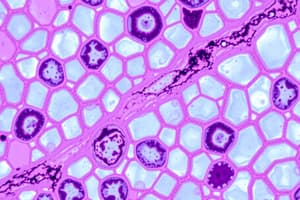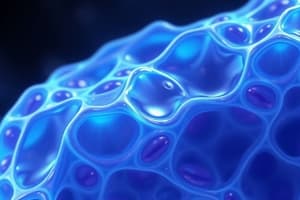Podcast
Questions and Answers
What is the Latin word for 'hair'?
What is the Latin word for 'hair'?
- Arrector
- Motor
- Epidermal
- Pili (correct)
What is the function of the arrector pili muscle?
What is the function of the arrector pili muscle?
- To regulate body temperature
- To make the hair stand up (correct)
- To protect the skin from the sun
- To produce keratin
What type of cells make up the hair shaft?
What type of cells make up the hair shaft?
- Dead, keratinized epidermal cells (correct)
- Living, keratinized epidermal cells
- Smooth muscle cells
- Nerve cells
What is the name of the structure at the base of a hair?
What is the name of the structure at the base of a hair?
Where are nails located?
Where are nails located?
What is the name of the extension of the upper layer of the epidermis at the base of a nail?
What is the name of the extension of the upper layer of the epidermis at the base of a nail?
What is the main difference between the keratin found in nails and the keratin found in skin and hair?
What is the main difference between the keratin found in nails and the keratin found in skin and hair?
What is the primary function of nails?
What is the primary function of nails?
Flashcards
Hair root
Hair root
The base area from which hair develops, found in the skin.
Hair shaft
Hair shaft
The visible part of the hair, consisting of dead, keratinized cells.
Keratin
Keratin
A tough protein found in hair, nails, and skin providing structure and strength.
Arrector pili
Arrector pili
Signup and view all the flashcards
Goose bumps
Goose bumps
Signup and view all the flashcards
Nail cuticle
Nail cuticle
Signup and view all the flashcards
Nails
Nails
Signup and view all the flashcards
Epidermis
Epidermis
Signup and view all the flashcards
Study Notes
Epithelial Tissue
- Composed of one or more layers of tightly packed cells
- Contains little to no extracellular matrix between cells
- Locations: covers body surfaces, lines body and organ cavities, forms most glands
- Inside the body - lining
- Outside the body - covering
- Characteristics: avascular (no blood vessels); reproduces readily (high rate of mitosis)
- Shapes:
- Squamous (flat, thin)
- Cuboidal (cube-shaped)
- Columnar (tall, column-shaped)
Types of Epithelial Cells
- Simple: single layer of cells; all cells contact the basement membrane
- Pseudostratified: appears to have multiple layers but only has one; all cells contact the basement membrane
- Stratified: two or more cell layers; only basal layer contacts the basement membrane
Glands
- Secrete mucous
- Glands may be exocrine or endocrine
- Exocrine: secrete into a duct to take the secretion away from the gland; examples: salivary glands, sweat glands
- Endocrine: produces & secretes hormones into the circulatory system; examples: thyroid, adrenal, pituitary
Functions of Epithelial Tissue
- Secretion: glands secrete enzymes, hormones, and lubricating fluids
- Absorption: in the small intestine, capable of absorbing nutrients from digested food
- Protection: covers body structures to protect against mechanical, chemical, biological, and dehydration damage
- Sensation: contains sensory nerve endings located in the skin, eyes, nose, and tongue
- Transportation: diffusion, excretion, lubrication, cleaning
Connective Tissue
- Connective tissue proper: loose connective tissue (areolar, adipose, reticular), dense connective tissue (dense regular, dense irregular, elastic)
- Supportive connective tissue: cartilage (hyaline, fibrocartilage, elastic), bone
- Fluid connective tissue: blood, lymph
Functions of Connective Tissue
- Connect, support, and transport by binding structures together; provides support
- Provides support
- Filling spaces
- Transporting nutrients, wastes, and gases
- Storing energy in the form of fat
- Producing blood cells
- Helping repair tissue damage
Cells in Connective Tissue
- Osteoblasts: produce new bone tissue
- Osteocytes: provide nutrients for formed bone
- Fibroblasts: secrete fibres and ground substance (matrix) in connective tissue
- Macrophages: engulf and destroy foreign material
- Plasma cells: cells of the immune system
- Mast cells: produce histamine, causing blood vessels to dilate
Muscle Tissue
- Cells = myocytes
- Contract and move body
- Types:
- Skeletal: movement, protection, heat production, posture
- Smooth: movement of internal substances (food, urine, baby, blood, air)
- Cardiac: pumps blood through heart and all blood vessels
Nervous Tissue
- Neuron: regulates the functioning of the neuron; carries impulses to cell body
- Synapse: small space between axon and dendrite of adjacent neurons
- Locations: brain, spinal cord, peripheral nerves
Membranes
- Four main membranes:
- Serous: secrete a watery substance; double layered; parietal (lines cavity) and visceral (covers organs) membranes; examples: parietal/visceral pleura, parietal/visceral pericardium
- Mucous: lines cavities that open to the outside; secrete thick, slippery mucous; examples: urinary, digestive, respiratory systems
- Cutaneous: skin; covers entire outside of the body
- Synovial: lines cavities of free-moving joints; synovial fluid = lubricant
Skin
- 7 Main Functions: protective covering, regulates body temperature, slows water loss, contains sensory receptors, synthesizes chemicals, excretes small amounts of waste, synthesizes vitamin D
- Structure:
- Epidermis
- Dermis
- Hypodermis
- Accessories: hair follicles, sweat glands, sebaceous glands, nails
Accessory Organs of Skin
- Hair follicles: develop from epidermal cells; react to fear and cold
- Nails: modifications of epidermis; protect fingers and toes
- Sebaceous glands: lubricate hair and skin; secrete oil
- Sweat glands: produce sweat; excretes small amounts of waste
Apocrine & Eccrine Sweat Glands
- Eccrine glands: widespread; located on hands, feet, and forehead; secrete sweat to regulate temperature; blood vessels dilate
- Apocrine glands: located in the armpits and groin; secrete a thicker sweat; have a strong odour.
Studying That Suits You
Use AI to generate personalized quizzes and flashcards to suit your learning preferences.




